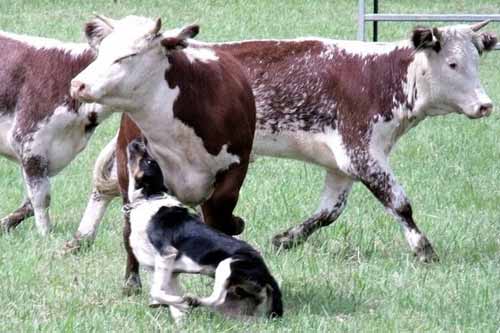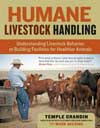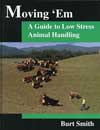Cattle Shrink and Handling Stress:
How Much Are They Costing You?

Image Credit: nicephotog
Stress during cattle handling, transport, processing, and marketing has a huge hidden financial cost to your business. Not only does cattle stress make meat tough and cattle more disease-prone, but it also causes cattle shrink, which is the unnecessary weight that is temporarily lost through manure, urine, and fluid loss from body tissues - valuable weight that you won't get paid for when the cattle are weighed at auction time.
In this article I am going to show you the cold hard numbers (in dollars and cents) that cattle stress costs your business, using an example commercial cattle ranch that sells 200 animals per year, averaging 825 lbs per animal at sale time, with an average cattle price of $1.20/lb (live weight). The numbers will surprise you!
Cattle Shrink
Dirty bums and a greasy corral or truck floor are not just inconveniences, they are signs of unnecessary weight loss in your cattle on the way to the market.
That weight loss is called shrink. Shrink is caused by the short term loss of manure and urine during handling, as well as the loss of fluids from body tissues, which has more long-term consequences.
Some shrink is normal. Expect 3% shrink (a short-term reduction of 3% in the animal's total body weight) during sorting and handling.
But stressful cattle handling practices like shouting, electric cattle prods, over-filling cattle trucks, under-filling cattle trucks, rough transport, long trucking distances, and so on will make this shrink considerably worse. On the other hand, learning low-stress cattle handling strategies will minimize this shrink, which will considerably raise your check on sale day!
Reduce Cattle Shrink
Check out this fact sheet from the Ontario Ministry of Agriculture, explaining the various causes and dramatic numbers involved when stress causes cattle shrink!
The example provided by the Ontario Ministry of Agriculture's fact sheet about cattle shrink (see inset on the right) provides some stark numbers: If a 600 lbs calf is penned, sorted, weighed, and then transported for 8 hrs over 640 kilometers (400 miles), you can expect 0.5% shrink during the first 30 minutes of sorting, 3% shrink during weighing and loading, 4% shrinkage during the first 4 hours of trucking, another 1% shrink during the second 4 hours of trucking, and another 2.5% shrink related to the distance trucked. That's a total of 11% shrinkage, or 66 lbs of body weight! Per animal!
Obviously these are not fixed numbers. Calm handling practices, not over-filling or under-filling the truck, providing stable footing and a gentle ride during transport, and otherwise reducing stress during cattle processing will reduce this shrink somewhat. Stressful handling practices will make them worse.
Furthermore, only the first 6% of cattle shrink is "fill" from the digestive system - manure and urine - that will be recovered during the next meal. After that the shrinkage comes from loss of vital fluids from body tissues, and that kind of shrink takes weeks to months to recover (10-36 days!)
Let's put some numbers to this exercise using our example 200-head cattle herd...
The Cost of Stressful Transport and Handling
If each animal experiences an extra 1 hour of high-stress rodeo during round-up, sorting, and loading on the way to the auction, that 1 hour of extra stress is going to cause between 1-2% of extra unnecessary shrink in the cattle weights by the time the cattle are weighed at the auction.
200 cattle x 825 lbs x 1% shrink x $1.20/lb = $1980.
That shrink can easily rise as high as 6% if the rodeo in the corral takes even longer or if the trucking is stressful or long.
At 6% shrink that translates into $11,880 on a herd this size!
While it is fraudulent to stuff cattle full of hay or water just before weighing, dirty bums are a sure sign that stressful handling strategies are causing your cattle to shed unnecessary extra weight all over the corral, truck, and auction yard floor. That's perfectly legal weight that should have been accounted for on the weigh scales, which you've lost simply by not learning low-stress cattle handling practices!
The Cost of a Reputation for Raising Nervous or High-Strung Cattle
Cattle shrink is not the only way that you're losing a lot of money if you're not using low-stress cattle handling practices.
Stress is sticky. It doesn't simply disappear at the end of the day just because the cattle appear to have calmed down again. It's after-effects will linger, affecting cattle performance for weeks or even months afterwards.
Cattle buyers are therefore going to shy away from nervous cattle because flighty nervous cattle have a lower feed conversion rate (less efficient at turning forage into beef) and they will be more prone to shipping fever and other diseases. All of which makes them more expensive to own. Consequently, cattle that look nervous when they arrive in the auction rink will not command as high of a price.
And cattle buyers have long memories - the feedlot operators who ultimately buy the cattle keep track of the performance of cattle from various sources in their feed programs. Cow-calf producers get a reputation for producing either calm easy-keeping cattle or nervous flighty low-efficiency cattle. So, expect your reputation to further add to the premium or discount that you receive at the auction.
Even a minor $0.05 discount on our example 200-head herd translates into a loss of $8,250. Double that for a not-unreasonable 10¢ discount!
If you're direct marketing your beef, you're not immune to that discount. Beef from nervous cattle will be tougher. That means less satisfied customers, which translates into more returned beef sales and a higher churn rate in your customers. Plus your customers will be less inclined to advertise for you for free through word-of-mouth recommendations.
And if that wasn't enough already, stressed cattle are also more prone to being "dark cutters," which are a total write-off when they are slaughtered. Even mild unnecessary extra stress will reduce your cattle's dress percentage at the butcher's simply because of the fluid loss from body tissues means that the meat will weigh less (in addition to being tougher).
The Cost of Stress on Your Production Costs and Stocking Rates
Using stressful cattle handling practices isn't just going to affect your cattle buyers' production costs. You've already paid a heavy price before your cattle even leave your farm.
If stressful handling techniques are a common issue on your farm, your cattle will be less efficient at turning forage into beef. That means your production costs will also be higher.
Stress doesn't disappear the moment you finish handling the cattle. It is sticky and can persist for weeks or months, thus lowering the efficiency of your cattle's ability to gain weight on pasture. Less efficient feed conversion means cattle weight gains are more expensive. Your cattle will require more winter feed and more feed supplements, and your cattle will take longer to reach their target weights.
And all that also affects your stocking rates. By requiring more feed and taking longer to grow, your cattle will require more acreage per cow to achieve the same weight gains, which means you can raise less cattle on your land base compared to someone with less stressful cattle handling practices.
Furthermore, the long-term effect of stress also has a negative impact on your cattle's immune systems, making them more prone to disease, which raises your cattle health costs.
So, let's try to put some rough numbers on that and assume a very slim 5-7% increase in the production expenses as a result of poor feed conversion, higher feed costs, higher disease pressure, and lower stocking rates caused by not using low-stress cattle handling practices.
Our example 200-head herd has gross profits of $198,000 per year (200 cattle x 825 lbs x $1.20/lb average sale weight = $198,000).
Let's assume that this farm makes $80,000 per year before taxes and mortgage payments. That implies that production expenses work out to around $118,000 per year.
A conservative 5-7% increase in the production expenses works out to $5900-$8260.
Adding Up the Cost of Stress on our Example Cattle Herd
If we add together the effects of cattle shrink, price discounts at the auction, and increased production costs, the sum is quite staggering.
|
Shrink = $1980 - $11,880 Auction Price Discount = $8250 - $16,500 Higher Production Costs = $5900 - $8260 Total = $16,130 - $36-640 |
That's a lot of cash to leave on the table!
In other words, an hour of stressful unnecessary rodeo in the cattle corral during processing, sorting, or on sale day, repeated consistently every time the cattle are handled, could easily translate into a real financial cost of $16,130 - $36,640 for our example cattle farm. That's the equivalent of 20-45% of the farm's net profits!
So the next time you think that selling cattle through the commodity cattle auctions gives you no control over the check you take home, remember how much of a difference you can make to your take-home check simply by learning low-stress cattle handling practices.
Further Reading:
Books:
(Disclosure: I get commissions for purchases made using Amazon links in my post.)
 |
Grass Fed Cattle: How to Produce and Market Natural Beef#CommissionsEarned by Julius Ruechel |
 |
Humane Livestock Handling: Understanding livestock behavior and building facilities for healthier animals#CommissionsEarned by Dr. Temple Grandin |
 |
Moving 'Em: A Guide to Low Stress Animal Handling#CommissionsEarned by Burt Smith |
Related Articles:
|
Reducing Cattle Shrink - article by the Ontario Ministry of Agriculture. |
If you enjoyed this article, make sure you sign up for my email notifications to get a heads up when I release my next cattle farming!
Sign up for FREE Cattle Farming Updates
|
Share: |
|




